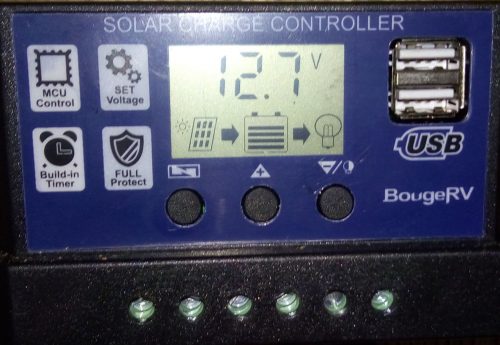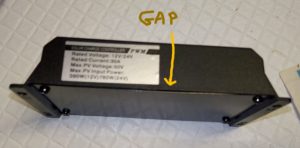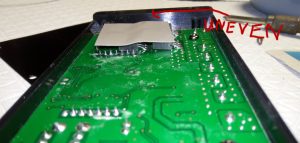If you’ve perused the web for lower cost charge controllers, the BougeRV 30A controller I’m going to be talking about ragging on here looks like this:
…you’ve probably seen similar-looking ones but with different colors/logos (Allpowers, CoZroom, Mohoo, etc). Essentially the basic controller without a temperature sensor. Oh, except when the others have the pictures with the Ours/Theirs comparison, the BougeRV is what they mean by “Theirs”.
I bought 2 of these charge controllers, and boy… what a disappointment. I’ll start with the major issue, then move on to the other stuff I came across along the way.
The Major Issue (it’s really a 5A controller, at least on the output)
Before anyone asks whether it was being used in overheated/hot conditions, the testing was performed in 10˚C ambient temperatures.
Unit #1: I had the unit connected to an ~10A load. The unit would turn on the load for a fraction of a second, then shut off and go into overload. Overload is denoted by a flashing light bulb on the display. After what I’d wager was 20-30 seconds, the unit would try again. Same thing.
This load didn’t have any real surge/inrush current beyond a couple tiny capacitors. I pulled out the bench supply and some other equipment, which resulted in discovering the following:
- Nearly any capacitor (present in… well virtually all electronics) will cause an initial overload, which the unit will recover from 20-30 seconds later, providing the capacitor hasn’t been drained in that time.
- The unit itself once powered will get up to about 4.5A of output. By the time you ask it for 5A it dies out and never recovers.
Unit #2: This unit was slightly more successful, but only slightly. The short version here:
- Same issue with capacitors (triggers overload on 1st attempt, recovers and runs on 2nd).
- Can provide 5-6A of output for about 5 minutes, then goes into overload. Recovers after the next cycle (20-30 seconds), and stays on for about 1-2 minutes. This repeats, with the length of time before it hits overload steadily decreasing.
…if I’d only purchased 1 unit, I might have suspected a dud. But since both units had severe issues around the 5A mark I suspect it’s a problem across the line.
I wouldn’t be surprised by ~5A from a really shoddy 10A version. So perhaps this is a really shoddy 10A version re-stickered as 30A so it can be sold for more money.
Other stuff #1 – poor workmanship
Take a gander (click for larger images):
1 of the units had the obvious gap caused by the panel bowing out when pressed against the mosfets. BOTH had the uneven mosfets which were at such a bad angle that very little contact was made with the heatsinking “panel”.
Even if the things performed decently out of the box, I’d be surprised if there was much in the way of longevity.
Other stuff #2 – things that may or may not apply to units from other manufacturers (not necessarily BougeRV-specific but might be)
- Wire sockets are small, shallow, and flex – getting 10 gauge wires in and tightened down without snapping anything wasn’t fun.
- During testing, when the load was manually forced on via the button (after going off automatically via the under-voltage limit and then letting the voltage climb back up a bit), it was impossible to shut off again without disconnecting everything from the unit to force it to reset. Left alone it will have killed the battery.
- Incorrect battery voltages listed. One showed +0.2v. The other showed -0.1v.
- The buttons when programming often aren’t very responsive (have to try pressing multiple times), aggravated by the inherent delay before the display actually updates.
- According to the manual, sealed/gel/flooded (b01, b02, b03) settings correspond to the equalization voltages (14.4v, 14.2v, 14.6v). But since the voltages detected are wrong this is kind of useless. And since the manual doesn’t indicate if and when equalization automatically takes place (is it each charge cycle? is it monthly? does it even happen at all or is it a dummy setting?), this is really just an unpredictable liability.
- The adjustable low-voltage-disconnect range is quite poor. Between 9.0v to 11.3v. Even the highest value there (11.3v) is running the battery under 10% charge which is extremely hard on batteries and will result in them having short lives (and let them freeze/crack in the north during winter which is usually instant death for a battery). The upper limit should arguably be at least 12.0 volts to allow the battery to stay >= 40% charge for longevity reasons.
Anything good? Is it useful at all?
The ability to at least configure float/cut-in/cut-out voltages is a plus, though you’d need to compensate for the incorrect voltage reading on your particular unit.
If you’re not powering a load, I suppose it’ll serve as a battery maintainer with an unpredictable equalize function. However, a cheap buck converter would probably be a little better (and cheaper) here if you’re just wanting to float some batteries and don’t need the fancy display or the USB ports (though you could use a 2nd buck for USB and get a standalone voltmeter display).
If you *are* powering a load… I’d look elsewhere. If you already bought one, are stuck with it (can’t return it), and have run into similar issues with current-handling, I suppose you could have the outputs trigger some high-current relays that do all the power handling.
To sum it up:
- Delivers a max of 5A instead of the rated 30A (you may as well buy a cheaper 10A controller). Can’t really power a load.
- Inaccurate voltage.
- Annoying to wire.
- Poor workmanship (panel/mosfets).
There really isn’t much more to say about this thing. If you’re shopping for a charge controller and were considering the Bouge RV, based on my experience I’d definitely suggest buying something else.


Thanks a lot!
I've moved onto using Arduinos to create custom controllers, but obviously that's not an option for everyone.
One option if you get a cheaper unit that works for you in terms of charging (but not trustworthy providing load power) could be to disconnect the controller from the battery bank and hook up your 12v vacuum to the battery directly (fuse it just in case). Once done, disconnect vacuum and reconnect controller. Not a great option if you prefer to hardwire in loads though, and obviously requires sufficient battery capacity and the hassle of disconnecting/reconnecting the charge controller. Also doesn't help if the charge controller overcurrents when trying to charge the battery again when reconnected. This is more of a "trying to make the most of a bad situation" thing.
Hmm... maybe someone can chime in with a recommendation if they've got a unit that's been actually been working well for them.